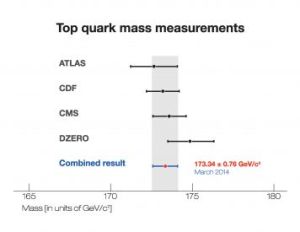Mar 24 2014
Scientists working on the world’s leading particle collider experiments have joined forces, combined their data and produced the first joint result from Fermilab’s Tevatron and CERN’s Large Hadron Collider (LHC), both very powerful particle colliders on Earth. Scientists from the four experiments involved — ATLAS, CDF, CMS and DZero — announced their joint findings yesterday on the mass of the top quark, the heaviest known elementary particle, at the Rencontres de Moriond international physics conference in Italy.
 This graphic shows the four individual top quark mass measurements published by the ATLAS, CDF, CMS and DZero collaborations, together with the most precise measurement obtained in a joint analysis.Photo credit: Fermilab.
This graphic shows the four individual top quark mass measurements published by the ATLAS, CDF, CMS and DZero collaborations, together with the most precise measurement obtained in a joint analysis.Photo credit: Fermilab.
The University of California, Riverside’s Stephen Wimpenny, a professor of physics and astronomy, is one of the key scientists involved, and has been working on the analysis since last summer.
“It is the first analysis to combine the results from the four different big experiments at the LHC and the Tevatron — CDF and DZero at the Tevatron and ATLAS and CMS at the LHC,” he said. “It was performed by a team of four researchers representing the four collaborations involved. The results significantly improve the precision of the mass of the top quark.”
Together the four experiments pooled their data analysis power to arrive at a new world’s best value for the mass of the top quark of 173.34 +/- 0.76 GeV/c2. The analysis required a very detailed understanding of the detectors and the 11 measurements that contributed to the combination, paving the way for further improvements in the future.
The new precise value of the top-quark mass will allow scientists to test further the mathematical framework that describes the quantum connections between the top quark, the Higgs particle and the carrier of the electroweak force, the W boson. Theorists will explore how the new, more precise value will change predictions regarding the stability of the Higgs field and its effects on the evolution of the universe. It will also allow scientists to look for inconsistencies in the Standard Model of particle physics – searching for hints of new physics that will lead to a better understanding of the nature of the universe.
Point-like, the top quark has no size. It has the same mass as a gold atom and is one of the fundamental building blocks of nature. Understood as an ingredient of the particle soup just after the Big Bang, today the top quark does not occur naturally but must be created experimentally in a high-energy particle accelerator that can recreate the conditions of the early universe.
Experiments at the LHC at the CERN laboratory in Geneva, Switzerland, and the Tevatron collider at Fermilab near Chicago, Ill., are the only ones that have ever seen top quarks. The top quark’s huge mass (almost 200 times that of the proton in an atom’s nucleus) makes it one of the most important tools in physicists’ quest to understand the nature of the universe.
A total of more than 6,000 scientists from more than 50 countries participate in the four experimental collaborations. The CDF and DZero experiments discovered the top quark in 1995, and the Tevatron produced about 300,000 top quark events during its 25-year lifetime, completed in 2011. Since it started collider physics operations in 2009, the LHC has produced close to 18 million events with top quarks, making it the world’s leading top quark factory.
Each of the four collaborations previously released their individual top-quark mass measurements. Combining them together required close collaboration between the four experiments, understanding in detail each other’s techniques and uncertainties. Each experiment measured the top-quark mass using several different methods by analysing different top quark decay channels, using sophisticated analysis techniques developed and improved over more than 20 years of top quark research beginning at the Tevatron and continuing at the LHC.
UC Riverside is a member of both the CMS and DZero collaborations.
The joint measurement has been submitted to the electronic arXiv and is available at: http://arxiv.org/abs/1403.4427.